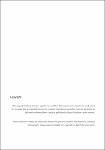Building Immersive Environments Towards Non-Human Models of Organizing Against Global Crisis
| dc.contributor.supervisor | Phillips, Mike | |
| dc.contributor.author | Varela Reis, Luis Andre | |
| dc.contributor.other | School of Art, Design and Architecture | en_US |
| dc.date.accessioned | 2023-08-21T08:06:40Z | |
| dc.date.issued | 2023 | |
| dc.identifier | 10566356 | en_US |
| dc.identifier.uri | https://pearl.plymouth.ac.uk/handle/10026.1/21247 | |
| dc.description.abstract |
The wolfanddotcom series of artworks seeks to establish new knowledge embedded in its practice within a nascent field combining the areas of aesthetic computation, interactive electronic arts, videogames, mythology, biology, human/non-human computer interfaces. Wolfanddotcom's research leads investigations on bio-electronic and imaginary arts alloyed with a mythological and non-human turn, mainly through the creation of dynamic art-sci constructs, in the form of mythological videogames and bio-electronic aggregates, by establishing multiple lines of flight onto a creative framework, seeking novel, procedural, immersive, cathartic and bio-electronic methods. With a final purpose of exploring new electronic-based arts’ aesthetic regions, unexampled connections between generative (Eno) technoetic (Ascott) arts, videogames, mythology, biology, 11 cyber-environments’ domains are conceived on a speculative neon paleolitikos epoch strata, a plateau which depicts aesthetic archeology from an imaginary geological age after the Anthropocene, featuring operational bio-electronic symbioses as aggregates combined from ruins of silica, transistors, algorithms, cells, plants, animals, electricity. The research practice has a particular focus on the wolf, a totem animal that lives in territorialized packs, an apex species for the ecosystemic balance it inhabits, currently endangered worldwide essentially for economic reasons and insensitivity to the issues of biodiversity and sustainable development. The focus on the wolf underlines a distinctive approach to art making, not only to contribute to the creation of new aesthetic knowledge, but also to induce in the user a positively transformative cathartic state in safe ilinxian regions, self-operated by the fruition of the created artworks. Assuming their power to change a person, these aesthetic, interactive and immersive experiences in non-human cybernetic themes and environments can in some way (even if not directly or measurably) enhance a critically conscious cyber-humanity, thus contributing to transform society and lead it to look at non-human organizational models as better responses to current socio-environmental global crisis, requiring urgent strategic survival action, supportive and coordinated like inbetween wolves, and ants and bacteria too, other natural models investigated in the series. From the macro-micro-structure of binary encoded information to the processual flow programs execute on hardware, electronic machinic phenomena produce fascinating links with biological processes, providing invaluable research models. The research departs from observations of these micro-electronic worlds akin to living entities, creating art-sci constructs (amalgams of biological and electronic hybrid elements over a variety of media) as experienceable cyber-environments twofold: mythological videogames, where human users, through computer vision, sound, networked or haptic sculptural interfaces, full body immerse as dragons, phoenixes, wolves, minotaurs, on procedurally generated virtual worlds sculpted solely from bio-electronic data; bio-electronic aggregates (lasers, visuals, sounds, electronic byte sequences, genetic and generative algorithms interwoven micro-granularly with biological byte streams, plants, ants, wolves), where the devices forge tangible non-human biological and electronic apparatuses, spurring hybridization upon execution. The research outcomes include interactive time spaces which summon play (Huizinga) and ilinx (Caillois) for human and non-human engagement, playful laboratories of non-human embodiment – self-inquiry and modification –, which broaden the base for establishing deeper human spiritual connections. They also include new static art-sci artifacts (3D sculptures, drawings, photographs, videos, organic paintings) entwined with the main interactive art-sci works. The overarching research ambition is that its outcomes may be not only effective contribution of new knowledge about interactive and immersive transformative tools/experiences, which subtly and acutely can contribute to reversing current emerging planetary crisis, but also as valid artistic instruments to speak of our time for future generations. | en_US |
| dc.language.iso | en | |
| dc.publisher | University of Plymouth | |
| dc.subject | mythological videogames | en_US |
| dc.subject | bio-electronic aggregates | en_US |
| dc.subject | wolfanddotcom | en_US |
| dc.subject | imaginary art | en_US |
| dc.subject | technoetic art | en_US |
| dc.subject | electronic art | en_US |
| dc.subject | artificial life | en_US |
| dc.subject | non-human cybernetics | en_US |
| dc.subject | immersive ilinxian environments | en_US |
| dc.subject.classification | PhD | en_US |
| dc.title | Building Immersive Environments Towards Non-Human Models of Organizing Against Global Crisis | en_US |
| dc.type | Thesis | |
| plymouth.version | publishable | en_US |
| dc.identifier.doi | http://dx.doi.org/10.24382/5090 | |
| dc.identifier.doi | http://dx.doi.org/10.24382/5090 | |
| dc.rights.embargodate | 2024-02-21T08:06:40Z | |
| dc.rights.embargoperiod | 6 months | en_US |
| dc.type.qualification | Doctorate | en_US |
| rioxxterms.version | NA | |
| plymouth.orcid.id | https://orcid.org/0000-0003-2400-229X | en_US |
Files in this item
This item appears in the following Collection(s)
-
01 Research Theses Main Collection
Research Theses Main


